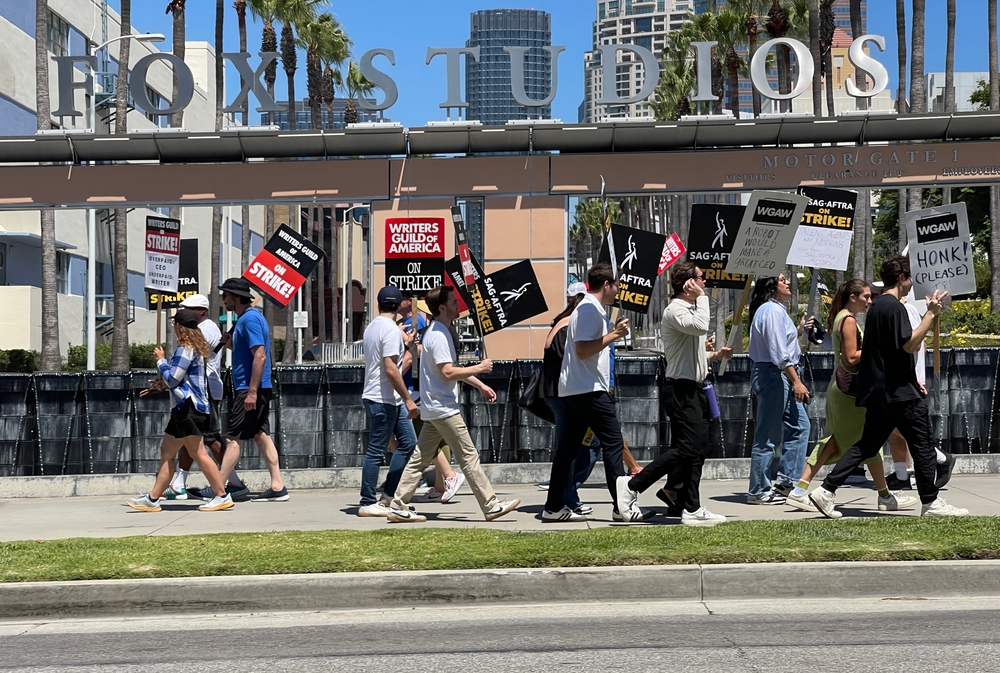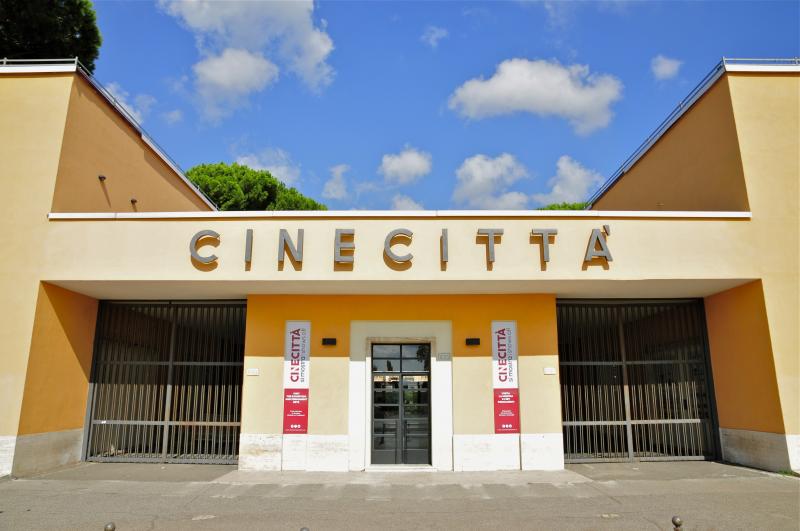As the Writers Guild of America (WGA) approaches its fifth month on strike, with the Screen Actors Guild and American Federation of Television and Radio Artists (SAG-AFTRA) right behind it, few moments have been so significant in the history of American film and television. While the United States does have its own proud history of protest, few nations can boast such a lengthy legacy of work stoppages in the modern age as can Italy, from its factories to its train lines. Yet given that the Italian productions continue to proceed normally, it’s worth wondering how this history of dissent — once so prevalent onscreen — has figured off of it. Can we expect our Italian neighbors to join the fray anytime soon?
Most conversations about Italian film history start with Cinecittà, and rightfully so. Famously founded in 1937 by Benito Mussolini, Duce Jr. Vittorio Mussolini, and futuro-fascist filmmaker Luigi Freddi, the “film city” of Cinecittà aimed to consolidate the efforts of Italian filmmakers, albeit around a fascist ideology.
Lest we forget, however, the studio was far from the beginning and certainly won’t be the end of the industry. At the dawn of the medium, the Italians were but a few steps behind the Lumière Brothers; by the turn of the century, they were at its forefront. In fact, by the early 1910s, production houses such as Caesar Film and Cines in Rome, Ambrosio and Itala Film in Turin, and Titanus (née Monopolio Lombardo) in Naples were churning out some of cinema’s first blockbusters just as the first studio was established in Hollywood.
The Italian protest precedent
Despite the success of epics such as Quo vadis? (1913), and Cabiria (1914), as well as the advent of avant-garde cinema, the onset of World War I, coupled with the strength of foreign competitors, threatened to destroy the industry. By 1919, the founders behind Caesar Film and Cines launched the Unione cinematografica italiana (UCI), drafting many other production houses alongside.
These producers proved incapable to withstand the financial demands of the industry, however. By 1920, the first Italian film world strikes were taking place, with casts and crews joining forces to demand a living wage. Caesar Film’s Giuseppe Barratolo reportedly resorted to slander, specifically against silent film mega-star Francesca Bertini and American filmmaking power duo Marie Doro and Herbert Brenon, each former UCI collaborators who maintained solidarity with the protestors. Having lost favor among politicians and journalists alike at this point, UCI was floundering both financially and creatively, even resorting to remakes such as that of Quo vadis? (1924).
Unfortunately for Barattolo and Company, the rehashed film’s commercial failure put the nail in the coffin of the UCI, and with it, to an extent, Italian cinema of the era. Even an attempt to shoot the American production Ben-Hur: A Tale of the Christ (1925) in Rome was beset by issues, namely a strike in remembrance of Giacomo Matteotti, a Socialist leader who had been kidnapped and killed by Fascists. After blackshirts began assaulting the striking workers, production was shifted back to Hollywood, and the Italian film industry of the era was effectively dead.
Cinecittà’s crumbling

Though Mussolini’s attempt to revive Italian cinema was a considerable success with the propagandist “White Telephone” films of the 1930s, the war left Cinecittà in literal ruins. The Allies, now in control of the studios, converted them into an internment camp, housing as many as 1,800 displaced people in 1945 alone (an inconvenience which, astoundingly, Roberto Rossellini simply shot around while filming his 1948 neorealist masterpiece, Germany Year Zero).
During the postwar period, Italian cinema would shine a rather favorable light on the striking worker, at least onscreen starting with Giuseppe De Santis and Gillo Pontecorvo’s documentary of the scioperi a rovescio — or reverse strikes — which laborers undertook in Lazio in 1951.
By 1965, when Gian Maria Volonté’s controversial staging of the German play The Vicar resulted in state censorship, students went on a hunger strike. Volonté, for his part, would translate that pro-sciopero energy into a visceral, scathing performance in Elio Petri’s La classe operaia va in paradiso (The Working Class Goes to Heaven) (1971), among countless other pro-proletariat films. In turn, Italian film was enjoying a golden age of creativity, thanks in no small part to Federico Fellini and his epic, world-building sets at Cinecittà (though not without the occasional snag, as when striking workers threatened to undermine the Cinecittà production of Fellini’s snake-bit Casanova in December 1975, much to the maestro’s continued dismay).
By 2012, Italian cinema was again suffering from foreign competition and underfunding. A shell of its former self, Cinecittà was now the site of flimsy soap operas or the rare foreign film, and its owners looked to alternative income streams to keep it afloat. A proposal to convert the site into a parking lot, hotel, and day spa, sent film workers picketing for 85 days in total until a new agreement could secure the future of the studios and their jobs alongside. Though no such jobs were guaranteed, plans to build on Cinecittà were shifted to the shuttered Dinocittà Studios — where, coincidentally, the 1957 production of Ben-Hur was staged to great success — resulting in a theme park called Cinecittà World.
Is an Italian strike in the pipeline?

Of late, things have been looking up for “Hollywood on the Tiber.” Even with Italy leading all European countries in domestic productions with 312 as of 2019, thanks in part to its generous tax breaks, the European Commission president Ursula von der Leyen and former Italian prime minister Mario Draghi announced plans to inject an astounding €300 million loan into the expansion of the studios via an EU post-pandemic recovery fund.
With the discovery of archaeological remains on the state-owned site where the studios were to be expanded, however, those plans fell through earlier this year, and though Cinecittà President Chiara Sbargia vows that Italian productions won’t be impacted by the American strikes, Writers Guild of Italy (WGI) President Giorgio Glaviano isn’t quite so confident.
“We are discussing the possibility of joining the [WGA] strike on this side of the Atlantic…with the other European guilds under the acronym FSE (Federation of European Screenwriters),” Glaviano told Italy Magazine. And while the Writers’ Guild of Great Britain — as well as those of Australia, Canada, Israel, Ireland, and Sweden — have already opted to stop work on American projects until the WGA has its terms met, things aren’t as simple for their Italian counterparts, who still have plenty to work out on their own turf.
“In Italy, we don’t yet have a national collective agreement for the category of screenwriters, and there are currently no minimum contracts established by law,” Glaviano said. “We are still fighting to get these victories.”
The WGI president noted that they are considering many options, from the collective refusal to sign future contracts to the threat of legal action with any unapproved adjustment of dialogue right down to the extreme possibility of “folding one’s arms and refusing to write, facing any consequence at whatever the cost.”
Either way, the WGI recognizes the extreme urgency of this moment, and is prepared to support the American battle however they can. For Glaviano, it’s about showing “respect for the value of quality work, and giving the commensurate economic recognition to our authors [...] Alongside all other artists, they are the very conscience of the nations.” From Hollywood to Hollywood on the Tiber, he adds, “their fight is our fight.”









